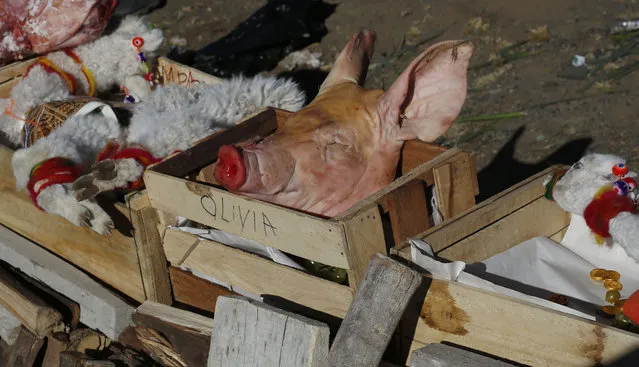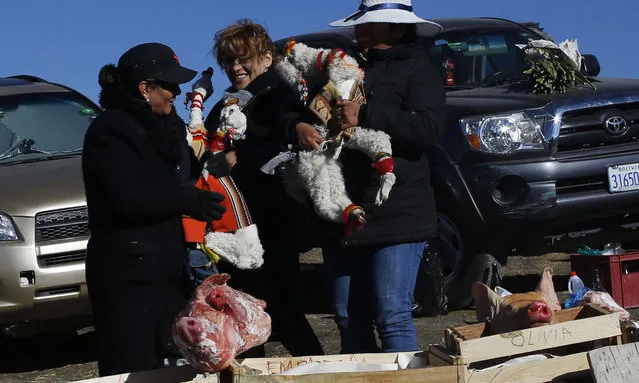“Pachamama is a goddess revered by the indigenous people of the Andes. She is also known as the earth/time mother. In Inca mythology, Pachamama is a fertility goddess who presides over planting and harvesting, embodies the mountains, and causes earthquakes. She is also an ever present and independent deity who has her own self-sufficient and creative power to sustain life on this earth. Pachamama is the wife of Pacha Kamaq and her children are Inti, the sun god, and Killa, the moon goddess. In Quechua cosmology, these are the four organizing principles of nature based on water, earth, sun, and moon. Llamas as well as burned, elaborate miniature garments are sacrificed to her. After the conquest by Spain, which forced conversion to Roman Catholicism, the figure of the Virgin Mary became united with that of the Pachamama for many of the indigenous people. In pre-Hispanic literature, Pachamama is seen as a cruel goddess eager to collect her sacrifices. As Bolivia began to form into a nation, however, Pachamama began to be – and to this day is – perceived as being benevolent and giving. She is also seen as nature itself. Thus, many who hold traditional beliefs in South America believe that problems arise when people take too much from nature because they are taking too much from Pachamama”. – Wikipedia

People buy offerings for the “Pachamama” (Mother Earth) at the witch doctor's street in La Paz, Bolivia July 31, 2015. According to Andean culture, the all the month of August is a time to give offerings to “Pachamama” to give thanks for their farms and health. The Aymaras use coca leaves, candies, animal fat, llama fetuses, some dried fruits, powdered minerals and alcohol during these rituals. (Photo by David Mercado/Reuters)

Llama fetuses which serve as part of the offerings for the “Pachamama” (Mother Earth) are seen at the witch doctor's street in La Paz, Bolivia July 31, 2015. (Photo by David Mercado/Reuters)

People buy offerings for the “Pachamama” (Mother Earth) at the witch doctor's street in La Paz, Bolivia July 31, 2015. (Photo by David Mercado/Reuters)

Aymara women are seen next to a stand with offering products at the witch doctor's street in La Paz, Bolivia July 31, 2015. (Photo by David Mercado/Reuters)

An Aymara woman rests at the witch doctor's street in La Paz, Bolivia July 31, 2015. (Photo by David Mercado/Reuters)

Aymara women sell offerings pieces at the witch doctor's street in La Paz, Boliva July 31, 2015. (Photo by David Mercado/Reuters)

A woman (C) shops for an offering at the witch doctor's street in La Paz, July 31, 2015. (Photo by David Mercado/Reuters)

Llama fetuses which serve as part of the offerings for the “Pachamama” (Mother Earth) are seen at the witch doctor's street in La Paz, July 31, 2015. (Photo by David Mercado/Reuters)

Offerings for the “Pachamama” (Mother Earth) are seen at the witch doctor's street in La Paz, July 31, 2015. (Photo by David Mercado/Reuters)

A pig's head and llama fetuses, are offered in honor of the “Pachamama”, or Mother Earth, on the sacred La Cumbre mountain on the outskirts of La Paz, Bolivia, Saturday, August 1, 2015. The month of August is the time people gather in the mountains of Bolivia to make offerings in honor of the earth goddess and ask for good fortune. (Photo by Juan Karita/AP Photo)

A witch doctor stands next to a car to bless it at 'La Cumbre' near La Paz, August 1, 2015. (Photo by David Mercado/Reuters)

A witch doctor sprays beer on an offering to goddess “Pachamama” at 'La Cumbre' near La Paz, August 1, 2015. (Photo by David Mercado/Reuters)

People gather at “La Cumbre”, a place for offerings to goddess “Pachamama” near La Paz, August 1, 2015. (Photo by David Mercado/Reuters)

People gather at “La Cumbre”, a place for offerings to goddess “Pachamama” near La Paz, August 1, 2015. (Photo by David Mercado/Reuters)

A witch doctor makes a ritual for a family at “La Cumbre” a place for offerings to goddess “Pachamama” near La Paz, August 1, 2015. (Photo by David Mercado/Reuters)

A witch doctor makes a ritual for a family at “La Cumbre” a place for offerings to goddess “Pachamama” near La Paz, August 1, 2015. (Photo by David Mercado/Reuters)

A man prepares offerings at “La Cumbre”, a place for offerings near La Paz, August 1, 2015. (Photo by David Mercado/Reuters)

Cyclists are seen next to a condor staute at “La Cumbre” near La Paz, August 1, 2015. (Photo by David Mercado/Reuters)

Women hold llama fetuses that will be offered during a ceremony in honor of the “Pachamama”, or Mother Earth, on the sacred La Cumbre mountain, on the outskirts of La Paz, Bolivia, Saturday, August 1, 2015. (Photo by Juan Karita/AP Photo)

An Aymara priest leads a prayer after an offering ceremony to “Pachamama”, or Mother Earth, on La Cumbre, a mountain that is considered scared ground, on the outskirts of La Paz, Bolivia, Saturday, August 1, 2015. (Photo by Juan Karita/AP Photo)

People burn offerings to “Pachamama”, or Mother Earth, and ask for good fortune on La Cumbre, a mountain that is considered sacred ground, on the outskirts of La Paz, Bolivia, Saturday, August 1, 2015. (Photo by Juan Karita/AP Photo)
02 Aug 2015 12:27:00,
post received
0 comments
